Analys
High risk for repeated attacks. Bearish concerns overstated


For two days in a row the Brent crude oil price has traded quite hard to the downside during intra-day trading before kicking back up again towards the close. A lot of the gains following the attacks on Saudi oil infrastructure almost two weeks ago have now been given back. Brent closed at $60.22/bl on Friday 13 September just before the attacks. Though having given back a lot of its gains (it spiked to $71.95/bl on Monday Sep 16) Brent has struggled to close below the $62/bl line.
What is notable is that following the Brent low close of $56.23/bl on 7 August Brent has been on a gradual trend higher irrespective of the attacks on Saudi Arabia. This matches well with the fact that US crude oil stocks declined by 70 million barrels from early July to early September.
The global oil market now seems to be so accustomed to living in oil affluence since 2014 that not even a damaging attack at the heart of the global oil market is able unnerve the market much with oil prices now just a tiny bit higher than before the attacks. Real action, real physical tightness in the spot market is probably what is needed to pull the market out of its current complacency.

The market is now “bean-counting” how much oil is lost from the attacks. What really matters in our view is the repetition risk for new attacks. In our view this risk is very high but there is hardly any risk premium in the market for this as we can see.
The front-end of the Brent crude oil curve has been in backwardation continuously since early this year signalling a draw-down in crude oil inventories and a tight front-end crude oil market. This tightness has not manifested itself as elevated flat prices as the whole crude oil curve has been pushed down by bearish bearish sentiment for the global oil market balance for next year amid slowing global growth, strong non-OPEC production growth projections for 2020 and doubts over the abilities and willingness of OPEC+ to cut yet deeper if needed.
The global oil market is unlikely to run a 1 m bl/d surplus in 2020 due to IMO-2020 (barring a global recession). We do share some of the markets bearish concerns for next year, but we do not agree with all of them and we do not agree with the conclusion of many oil market balance forecasts for next year being strongly in surplus with need of further cuts by OPEC+ to prevent a strong rise in OECD stocks. And neither do we agree with the view that OPEC+ has its back against the wall and has lost so much oil production volume to booming US shale oil production that it has now basically run out of bullets with little capacity to cut further if needed.
One key element in the global oil market balance next year in our view is the IMO-2020 sulphur bunker oil regulations. We have worked on this issue extensively over the past three years and written numerous reports on the subject. It is of course a hot topic and almost everyone who is writing about oil has nowadays written a report about it. What puzzles us is that as far as we can see no one accounts for the IMO-2020 event in their supply/demand balances for 2020. We have at least not seen any specific IMO-2020 line item in any of the balances we have seen.
As a consequence of the IMO-2020 regulations our base assumption is that a ballpark 1 m bl/d of high sulphur residue / bunker oil will be barred from legal use in global transportation. It will either be burned for heat, power or be stored. Typical HFO 3.5% bunker demand today is 3.5 m bl/d. Legal plus cheating demand in global shipping in 2020 will likely be about 1 m bl/d. Our guestimate is that some 1.5 m bl/d will be converted and transformed in refineries to other compliant products.
So in our view the IMO-2020 effect will put about 1 m bl/d of high sulphur residue /bunker oil on the side-line of the global transportation market. This is a clear and straight forward tightening of the global liquids market. The global transportation market thus needs an additional 1 m bl/d of hydrocarbon liquids from other sources instead. That is the IMO-2020 tightening we expect to see and we cannot identify such an IMO-2020 item in the supply/demand balances anywhere else in the market.
Everybody talks about the adverse impact the IMO-2020 will have on the global oil market, but no one takes account of it in any way in their supply/demand balances. Thus everyone sees a 1 m bl/d surplus for 2020 instead of a balanced market as we do.
OPEC+ has not run out of bullets. The key producers are instead producing close to all-time-high or 5yr averages. A key assumption in the market’s highly bearish concerns for next year is the assumption that “OPEC+ has run out of bullets” with no ability or appetite to cut deeper if needed. “They are cutting and cutting but are not able to get the oil price higher” is the market’s view of OPEC+ currently. It is true that production from the group has fallen sharply but that is primarily due to the sharp involuntary losses from Iran, Venezuela and Mexico. The key players being Russia, Kuwait, Iraq, UAE and Saudi Arabia are however producing either close to all-time-high levels or normal averages. They have hardly given away a single barrel.
Apparently Saudi Arabia has been cutting deep and delivered much deeper cuts than what it has been obliged to according to the agreement at the end of last year. But Saudi Arabia is to a large degree just playing with our minds and views. Saudi Arabia boosted production from 9.9 m bl/d in March 2018 to a monthly high of 11.1 m bl/d in November 2018 and then agreed to cut from that level down to 10.5 m bl/d. As such its production 9.8 m bl/d in August seems like a deep cut and over-compliance. Saudi Arabia’s average production over the past 60 months was 10.15 m bl/d. So Saudi Arabia produced only 0.3 m bl/d below its 5 yr average in August.
Our view is thus that the key players with control over their production have not at all given away much volume to booming US shale oil production and are fully in a position to cut more if needed or if they decide to do so.
High speed to Saudi Aramco IPO = high oil price volatility and elevated risks for renewed attacks. Saudi Aramco is now pushing hard to speed up the Aramco IPO at least for its partial and initial listing in Saudi Arabia. Research teams from the world’s largest financial institutions are now working around the clock to finalize draft assessments by mid-October. An as of yet non-published time-schedule of the IPO has it that Saudi Aramco will announce its IPO-plans on October 20th.
The recent attack on Saudi Arabia’s oil infrastructure is in our view just the last attack in a line of many. The attack has made it very clear that Saudi Arabia’s oil infrastructure is highly vulnerable and that it is very difficult to protect against attacks of the character two weeks ago. The weapons used were probably fairly low cost but had high precision and can be launched from almost anywhere. The attackers have detailed information of Saudi Arabia’s oil infrastructure and obviously also understands where to attack with high precision in order to make maximum damage with relatively small explosives.
It is clear that the market will managed and overcome the latest damages and supply outage in Saudi Arabia and repairs will be done. It will however draw down global inventories further and reduce Saudi spare capacity for several months to come. We do however think that the risk for repetitions of the latest attack is very, very high unless source of the reason for the attack is solved. I.e. the Iran and Yemen issues need to be resolved and defused. As long as those issues are not resolved we expect renewed attacks to take place. Especially so in the run-up to the Saudi Aramco IPO as it will have a negative effect on the listing in our view.
Strengthening cracks on refinery runs, Saudi attack and IMO-2020. US refineries are now reducing runs and crude consumption in the weeks to come until they ramp up again in mid-October. Thus US crude inventories are likely to rise (as we saw in this week’s data release) while product inventories are likely to decline along seasonal trends. This is likely to put strength to oil product cracks. Saudi Arabia has also imported oil products from the global market in order to compensate for domestically reduced refinery runs which also add strength to product cracks. The IMO-2020 switch-over is also moving closer and closer and we expect a very strong transitional Gasoil demand from the global shipping market in Q4-19 and Q1-20 just as we move through the Nordic hemisphere heating season peak. We see significant upside price risk for gasoil cracks in those two quarters. We think it is just a matter of time before much stronger mid-dist cracks kicks in fully in the spot market with a bullish effect rippling down the forward crack curve.
In sum: Bearish risks for 2020 are overstated
Bullishly:
- IMO-2020 will have a tightening effect of about 1 m bl/d
- OPEC+ has not run out of bullets
- High risk for repeated attacks and damages on Saudi Arabia oil infrastructure. Especially in the IPO run-up
Bearishly:
- A global recession if it materializes would have a strong bearish impact on oil prices and market
- A return of supply from Venezuela and/or Iran are clear bearish risks but we hold low probabilities for this
We expect Brent crude to average:
- 2020: $70/bl
- 2021: $70/bl
Analys
Brent crude set to dip its feet into the high $50ies/b this week

Parts of the Brent crude curve dipping into the high $50ies/b. Brent crude fell 2.3% over the week to Friday. It closed the week at $61.29/b, a slight gain on the day, but also traded to a low of $60.14/b that same day and just barely avoided trading into the $50ies/b. This morning it is risk-on in equities which seems to help industrial metals a little higher. But no such luck for oil. It is down 0.8% at $60.8/b. This week looks set for Brent crude to dip its feet in the $50ies/b. The Brent 3mth contract actually traded into the high $50ies/b on Friday.

The front-end backwardation has been on a weakening foot and is now about to fully disappear. The lowest point of the crude oil curve has also moved steadily lower and lower and its discount to the 5yr contract is now $6.8/b. A solid contango. The Brent 3mth contract did actually dip into the $50ies/b intraday on Friday when it traded to a low point of $59.93/b.
More weakness to come as lots of oil at sea comes to ports. Mid-East OPEC countries have boosted exports along with lower post summer consumption and higher production. The result is highly visibly in oil at sea which increased by 17 mb to 1,311 mb over the week to Sunday. Up 185 mb since mid-August. On its way to discharge at a port somewhere over the coming month or two.
Don’t forget that the oil market path ahead is all down to OPEC+. Remember that what is playing out in the oil market now is all by design by OPEC+. The group has decided that the unwind of the voluntary cuts is what it wants to do. In a combination of meeting demand from consumers as well as taking back market share. But we need to remember that how this plays out going forward is all at the mercy of what OPEC+ decides to do. It will halt the unwinding at some point. It will revert to cuts instead of unwind at some point.
A few months with Brent at $55/b and 40-50 US shale oil rigs kicked out may be what is needed. We think OPEC+ needs to see the exit of another 40-50 drilling rigs in the US shale oil patches to set US shale oil production on a path to of a 1 mb/d year on year decline Dec-25 to Dec-26. We are not there yet. But a 2-3 months period with Brent crude averaging $55/b would probably do it.
Oil on water increased 17 mb over the week to Sunday while oil in transit increased by 23 mb. So less oil was standing still. More was moving.
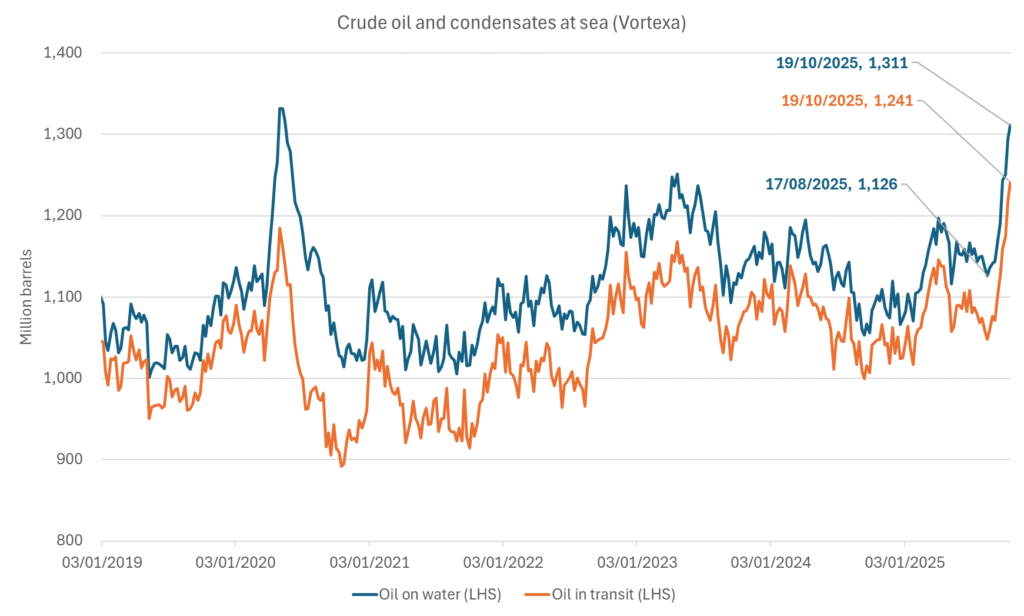
Crude oil floating storage (stationary more than 7 days). Down 11 mb over week to Sunday
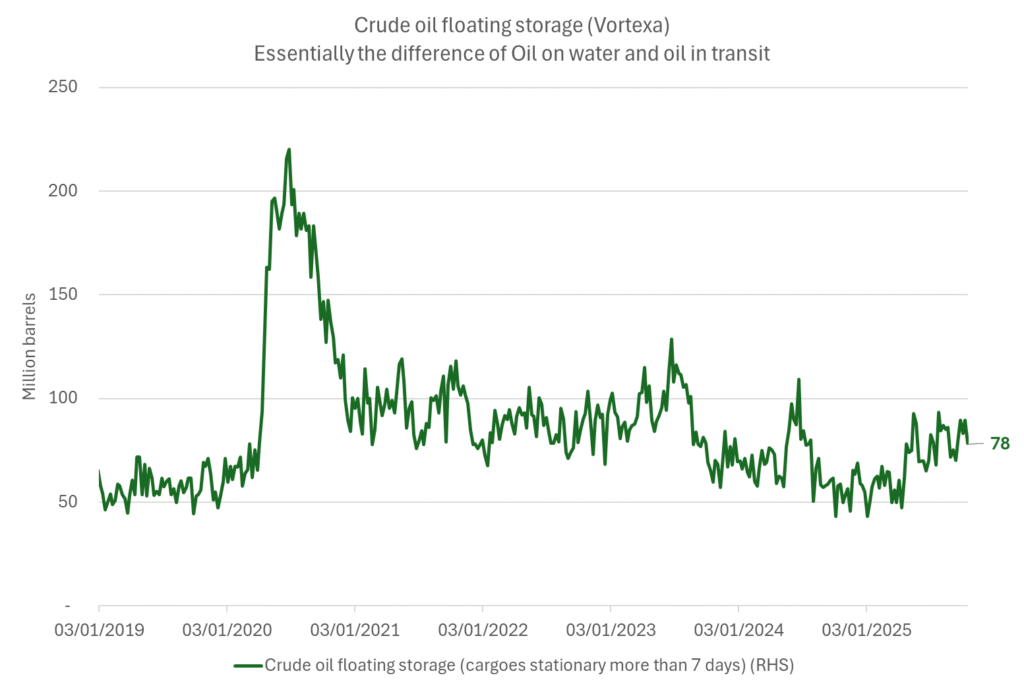
The lowest point of the Brent crude oil curve versus the 5yr contract. Weakest so far this year.
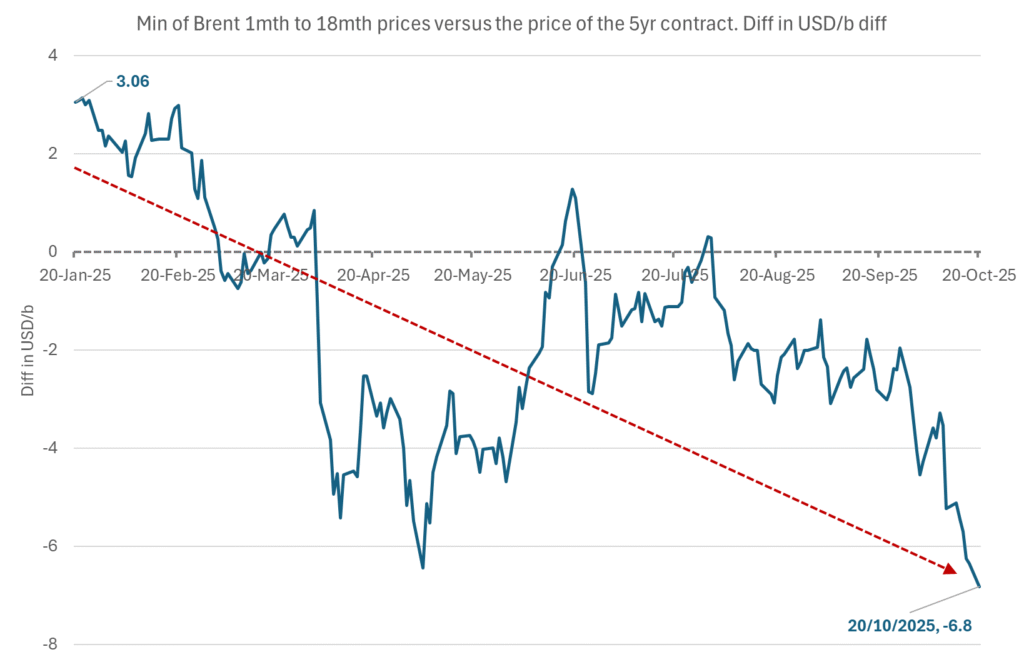
Crude oil 1mth to 3mth time-spreads. Dubai held out strongly through summer, but then that center of strength fell apart in late September and has been leading weakness in crude curves lower since then.
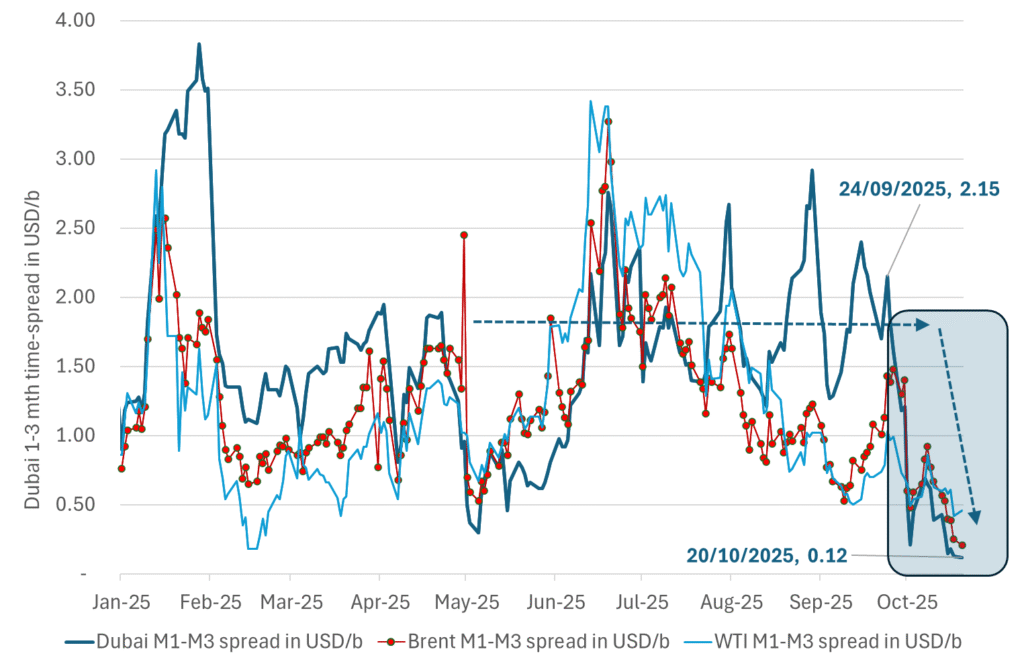
Analys
Crude oil soon coming to a port near you

Rebounding along with most markets. But concerns over solidity of Gaza peace may also contribute. Brent crude fell 0.8% yesterday to $61.91/b and its lowest close since May this year. This morning it is bouncing up 0.9% to $62.5/b along with a softer USD amid positive sentiment with both equities and industrial metals moving higher. Concerns that the peace in Gaza may be less solid than what one might hope for also yields some support to Brent. Bets on tech stocks are rebounding, defying fears of trade war. Money moving back into markets. Gold continues upwards its strong trend and a softer dollar helps it higher today as well.

US crude & products probably rose 5.6 mb last week (API) versus a normal seasonal decline of 2.4 mb. The US API last night partial and thus indicative data for US oil inventories. Their data indicates that US crude stocks rose 7.4 mb last week, gasoline stocks rose 3.0 mb while Distillate stocks fell 4.8 mb. Altogether an increase in commercial crude and product stocks of 5.6 mb. Commercial US crude and product stocks normally decline by 2.4 mb this time of year. So seasonally adjusted the US inventories rose 8 mb last week according to the indicative numbers by the API. That is a lot. Also, the counter seasonal trend of rising stocks versus normally declining stocks this time of year looks on a solid pace of continuation. If the API is correct then total US crude and product stocks would stand 41 mb higher than one year ago and 6 mb higher than the 2015-19 average. And if we combine this with our knowledge of a sharp increase in production and exports by OPEC(+) and a large increase in oil at sea, then the current trend in US oil inventories looks set to continue. So higher stocks and lower crude oil prices until OPEC(+) switch to cuts. Actual US oil inventory data today at 18:00 CET.
US commercial crude and product stocks rising to 1293 mb in week 41 if last nights indicative numbers from API are correct.
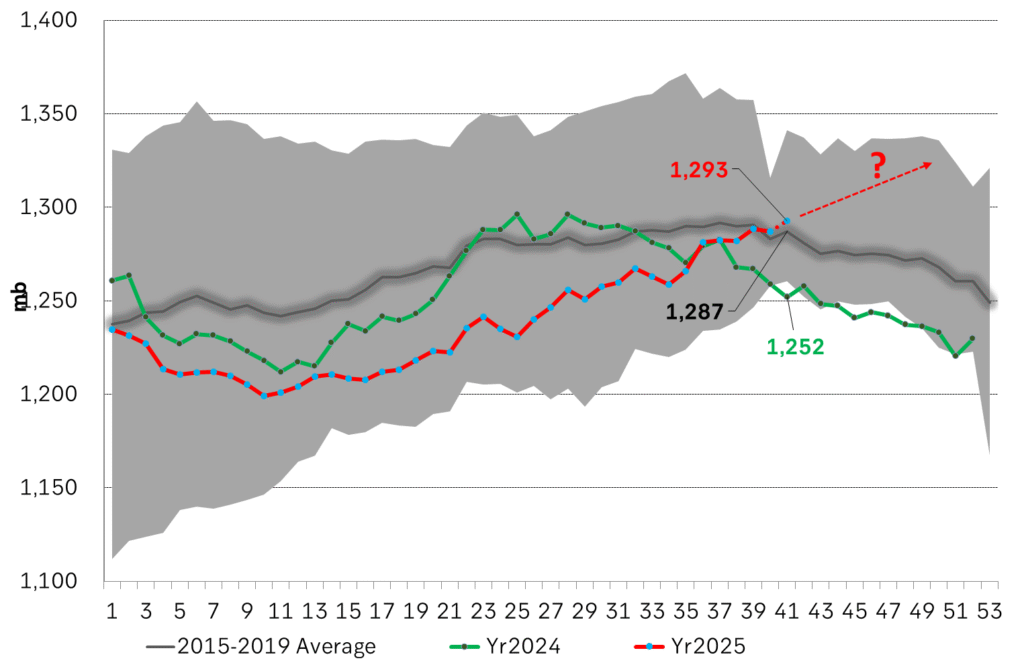
Crude oil soon coming to a port near you. OPEC has lifted production sharply higher this autumn. At the same time demand for oil in the Middle-East has fallen as we have moved out of summer heat and crude oil burn for power for air-conditioning. The Middle-East oil producers have thus been able to lift exports higher on both accounts. Crude oil and condensates on water has shot up by 177 mb since mid-August. This oil is now on its way to ports around the world. And when they arrive, it will likely help to lift stocks onshore higher. That is probably when we will lose the last bit of front-end backwardation the the crude oil curves. That will help to drive the front-month Brent crude oil price down to the $60/b line and revisit the high $50ies/b. Then the eyes will be all back on OPEC+ when they meet in early November and then again in early December.
Crude oil and condensates at sea have moved straight up by 177 mb since mid-August as OPEC(+) has produced more, consumed less and exported more.
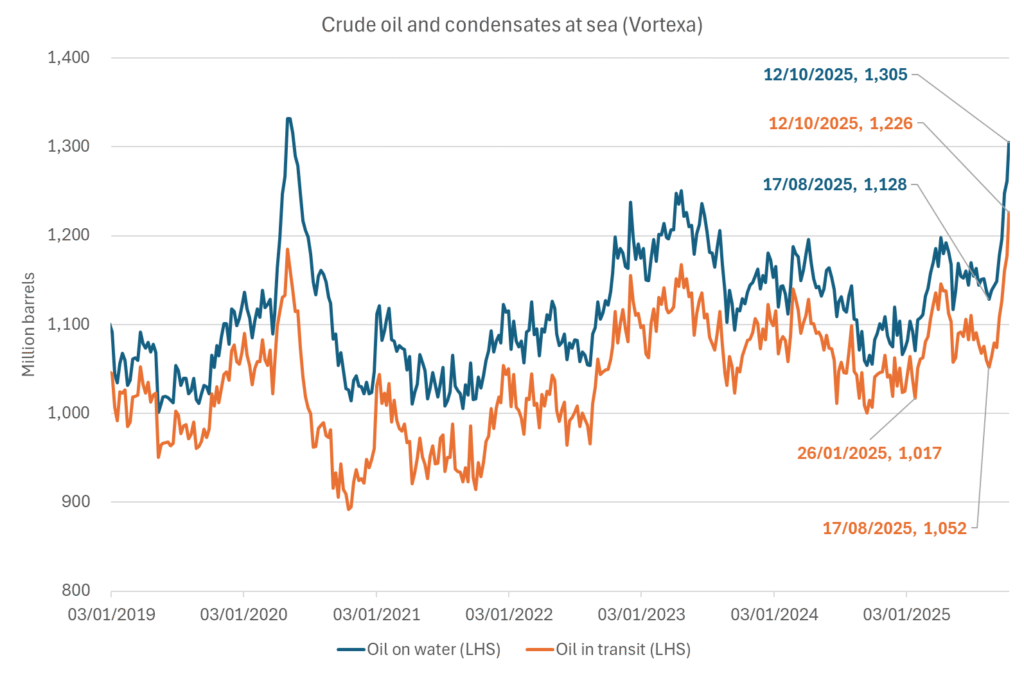
Analys
The Mid-East anchor dragging crude oil lower

When it starts to move lower it moves rather quickly. Gaza, China, IEA. Brent crude is down 2.1% today to $62/b after having traded as high as $66.58/b last Thursday and above $70/b in late September. The sell-off follows the truce/peace in Gaze, a flareup in US-China trade and yet another bearish oil outlook from the IEA.

A lasting peace in Gaze could drive crude oil at sea to onshore stocks. A lasting peace in Gaza would probably calm down the Houthis and thus allow more normal shipments of crude oil to sail through the Suez Canal, the Red Sea and out through the Bab-el-Mandeb Strait. Crude oil at sea has risen from 48 mb in April to now 91 mb versus a pre-Covid normal of about 50-60 mb. The rise to 91 mb is probably the result of crude sailing around Africa to be shot to pieces by the Houthis. If sailings were to normalize through the Suez Canal, then it could free up some 40 mb in transit at sea moving onshore into stocks.
The US-China trade conflict is of course bearish for demand if it continues.
Bearish IEA yet again. Getting closer to 2026. Credibility rises. We expect OPEC to cut end of 2025. The bearish monthly report from the IEA is what it is, but the closer we get to 2026, the more likely the IEA is of being ball-park right in its outlook. In its monthly report today the IEA estimates that the need for crude oil from OPEC in 2026 will be 25.4 mb/d versus production by the group in September of 29.1 mb/d. The group thus needs to do some serious cutting at the end of 2025 if it wants to keep the market balanced and avoid inventories from skyrocketing. Given that IEA is correct that is. We do however expect OPEC to implement cuts to avoid a large increase in inventories in Q1-26. The group will probably revert to cuts either at its early December meeting when they discuss production for January or in early January when they discuss production for February. The oil price will likely head yet lower until the group reverts to cuts.
Dubai: The Mid-East anchor dragging crude oil lower. Surplus emerging in Mid-East pricing. Crude oil prices held surprisingly strong all through the summer. A sign and a key source of that strength came from the strength in the front-end backwardation of the Dubai crude oil curve. It held out strong from mid-June and all until late September with an average 1-3mth time-spread premium of $1.8/b from mid-June to end of September. The 1-3mth time-spreads for Brent and WTI however were in steady deterioration from late June while their flat prices probably were held up by the strength coming from the Persian Gulf. Then in late September the strength in the Dubai curve suddenly collapsed. Since the start of October it has been weaker than both the Brent and the WTI curves. The Dubai 1-3mth time-spread now only stands at $0.25/b. The Middle East is now exporting more as it is producing more and also consuming less following elevated summer crude burn for power (Aircon) etc.
The only bear-element missing is a sudden and solid rise in OECD stocks. The only thing that is missing for the bear-case everyone have been waiting for is a solid, visible rise in OECD stocks in general and US oil stocks specifically. So watch out for US API indications tomorrow and official US oil inventories on Thursday.
No sign of any kind of fire-sale of oil from Saudi Arabia yet. To what we can see, Saudi Arabia is not at all struggling to sell its oil. It only lowered its Official Selling Prices (OSPs) to Asia marginally for November. A surplus market + Saudi determination to sell its oil to the market would normally lead to a sharp lowering of Saudi OSPs to Asia. Not yet at least and not for November.
The 5yr contract close to fixed at $68/b. Of importance with respect to how far down oil can/will go. When the oil market moves into a surplus then the spot price starts to trade in a large discount to the 5yr contract. Typically $10-15/b below the 5yr contract on average in bear-years (2009, 2015, 2016, 2020). But the 5yr contract is usually pulled lower as well thus making this approach a moving target. But the 5yr contract price has now been rock solidly been pegged to $68/b since 2022. And in the 2022 bull-year (Brent spot average $99/b), the 5yr contract only went to $72/b on average. If we assume that the same goes for the downside and that 2026 is a bear-year then the 5yr goes to $64/b while the spot is trading at a $10-15/b discount to that. That would imply an average spot price next year of $49-54/b. But that is if OPEC doesn’t revert to cuts and instead keeps production flowing. We think OPEC(+) will trim/cut production as needed into 2026 to prevent a huge build-up in global oil stocks and a crash in prices. But for now we are still heading lower. Into the $50ies/b.
-

 Nyheter4 veckor sedan
Nyheter4 veckor sedanOPEC+ missar produktionsmål, stöder oljepriserna
-

 Nyheter2 veckor sedan
Nyheter2 veckor sedanGoldman Sachs höjer prognosen för guld, tror priset når 4900 USD
-

 Nyheter4 veckor sedan
Nyheter4 veckor sedanEtt samtal om guld, olja, fjärrvärme och förnybar energi
-

 Nyheter3 veckor sedan
Nyheter3 veckor sedanBlykalla och amerikanska Oklo inleder ett samarbete
-

 Nyheter3 veckor sedan
Nyheter3 veckor sedanGuld nära 4000 USD och silver 50 USD, därför kan de fortsätta stiga
-

 Analys4 veckor sedan
Analys4 veckor sedanAre Ukraine’s attacks on Russian energy infrastructure working?
-

 Nyheter3 veckor sedan
Nyheter3 veckor sedanEtt samtal om guld, olja, koppar och stål
-

 Nyheter2 veckor sedan
Nyheter2 veckor sedanNytt prisrekord, guld stiger över 4000 USD








